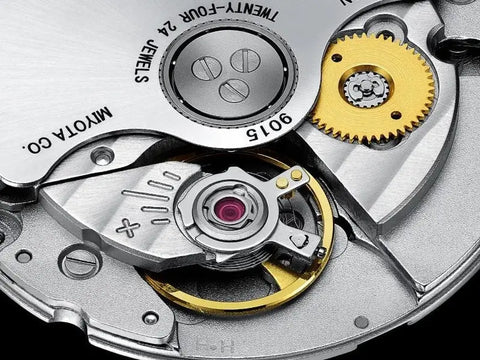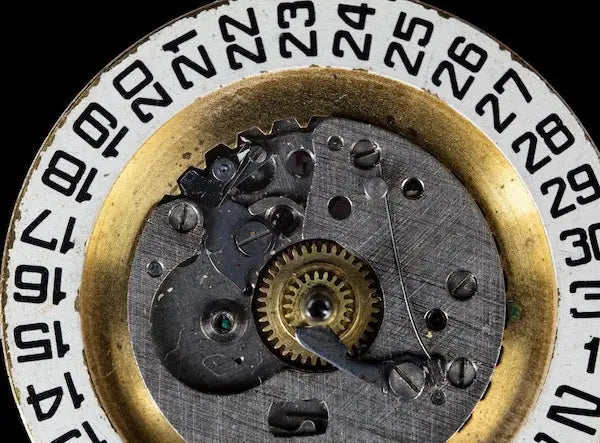Behind many independent or affordable brands, there is a discreet yet central player: Miyota. This Japanese company, founded in 1959 and integrated into the Citizen group, has been producing watch movements used worldwide for decades. The Miyota automatic movement has become a serious alternative to entry-level Swiss calibers and competing Japanese movements. But the question remains: are Miyota movements truly reliable and suited to the expectations of watch enthusiasts?
Contents
What is the Miyota movement?

Miyota is a company specialized in the manufacturing of watch movements. Its Saku factory, inaugurated in 2016, produces high-precision components intended for both established brands and emerging microbrands. The range covers three main families: quartz movements, mechanical hand-wound movements, and above all, automatic movements.
The Miyota automatic movement is the one that contributed to the brand’s international reputation. It powers thousands of watches and comes in several calibers suited to different needs. Among the best known are the robust 8215, launched in the 1970s, the 9015, introduced in 2009 to directly compete with the ETA 2824-2 and Sellita SW200, and the 9120, which offers additional complications such as day and month displays.
The advantages of the Miyota automatic movement

Before discussing its limitations, it is important to understand why the Miyota automatic movement has gained such a strong position in the watch industry. Several factors explain this success.
Reliability and robustness
Miyota movements are renowned for their durability. The 8215 caliber, mass-produced, has been used in watches worn daily for decades. The more modern 9015 is considered a serious alternative to entry-level Swiss movements. With its frequency of 28,800 vibrations per hour, a power reserve of about 42 hours, and a hacking seconds function, it is a complete and competitive movement.
Variety of calibers and complications
The Miyota lineup offers a diversity appreciated by watchmakers. The 8215 remains a benchmark for affordable watches. The thinner and more precise 9015 allows for slimmer cases while still ensuring solid chronometric performance. The 9120 expands the possibilities by adding complications such as a 24-hour indicator, month, and day display, making it a caliber used in more elaborate models. This variety shows that Miyota movements cover the needs of both simple watches and more complex ones.
Value for money
The success of Miyota movements is also explained by their competitive pricing. Microbrands find in them a reliable and affordable solution, less expensive than Swiss movements while offering better consistency than many Chinese clones. For the final buyer, this Japanese automatic movement ensures solid performance at a reasonable cost, making it possible to obtain affordable yet durable mechanical watches.
The limitations of the Miyota automatic movement
Despite its many advantages, the Miyota automatic movement does have some drawbacks pointed out by users and enthusiasts.
Noisy rotor
One of the most frequent criticisms concerns the rotor. In calibers like the 8215 or 9015, the rotor only winds the mainspring in one direction. When it spins freely in the other direction, it can produce an audible noise. This detail does not affect functionality but may surprise users accustomed to quieter movements.
Variable accuracy
The accuracy of Miyota movements is generally acceptable for their price range, but it varies depending on the piece. The 9015 is specified with an accuracy between –10 and +30 seconds per day, but some users observe larger deviations. A fine adjustment by a watchmaker can improve performance and reduce the deviation to about +5 seconds per day. This shows that, while reliable, Miyota movements sometimes require regulation to reach their full potential.
Counterfeit risks
The popularity of Miyota movements also attracts counterfeits. The 9015 caliber, in particular, sometimes circulates under different markings such as “CWMJ” instead of “Miyota.co.” These counterfeits can be problematic in terms of reliability and quality. To avoid unpleasant surprises, it is recommended to check the origin of the watches and to buy from trusted distributors.
Is the Miyota movement a good movement?
The Miyota automatic movement has proven its effectiveness over several decades. It combines a simple and robust architecture with a sufficiently wide range to adapt to different types of watches. Its strengths are proven reliability, good value for money, and availability, which has enabled many brands to offer affordable mechanical watches.
Its limitations exist: an audible rotor, accuracy that may require adjustments, and the risk of counterfeits. Nevertheless, these drawbacks do not diminish the overall value of the movement. For enthusiasts looking for a durable mechanical watch without paying the prices of Swiss calibers, the Miyota automatic movement is a logical and widely adopted choice.


What does GMT mean for a watch?
How does a tachymeter work on a watch?